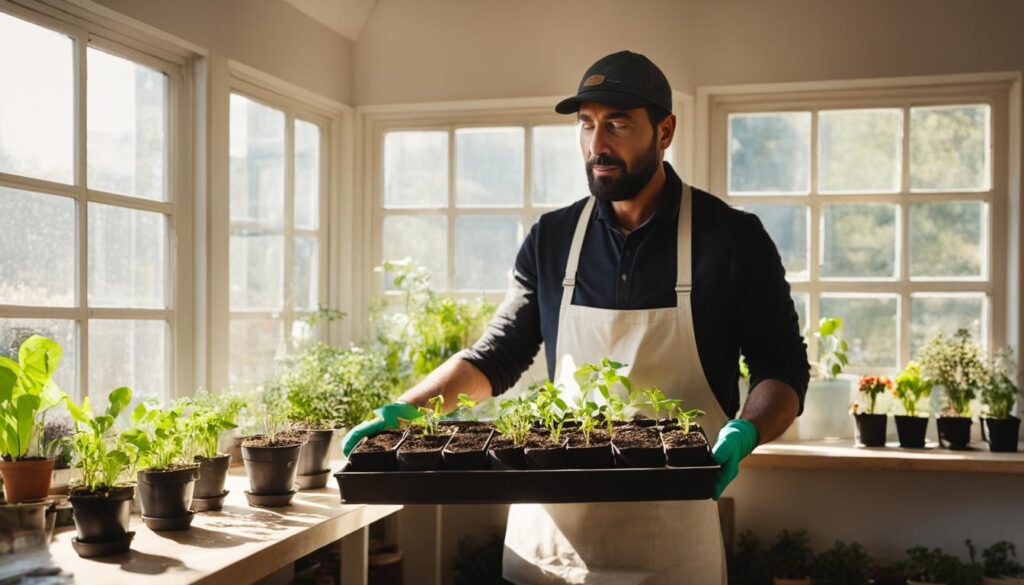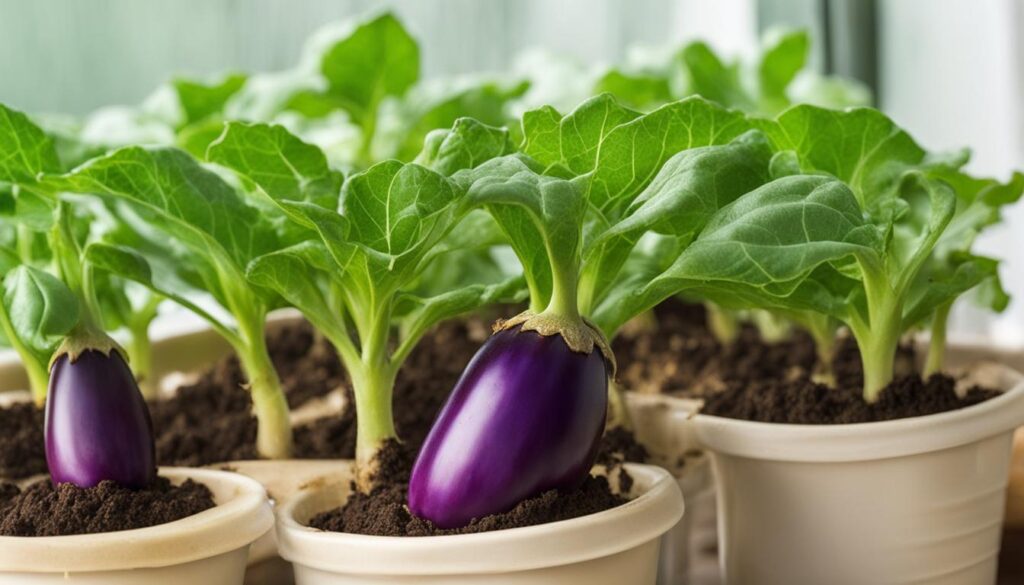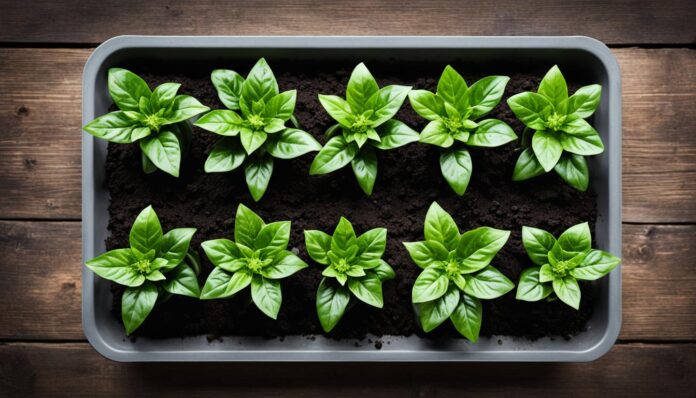Starting seeds for slow-growing plants like peppers and eggplants indoors is a crucial step in ensuring a successful growing season. These plants require a longer and hotter growing period, which can be achieved by starting seeds indoors under controlled conditions. Not only does this method give you access to a wide variety of pepper and eggplant varieties, but it is also a cost-effective way to grow these delicious vegetables.
Key Takeaways:
- Starting seeds indoors is essential for slow-growing plants like peppers and eggplants.
- It gives you a head start on the growing season and access to a variety of varieties.
- Ensure you start seeds at the ideal time, 6-8 weeks before the last frost date.
- Follow proper seed starting steps, including using good quality soil and clean containers.
- Provide adequate lighting for optimal seedling growth, preferably with grow lights.
Why start seeds indoors?
Starting seeds indoors offers numerous benefits for gardeners. Whether you’re a seasoned enthusiast or a beginner, indoor seed starting can give you a head start on the growing season and lead to healthier plants. Additionally, it allows you to cultivate a wide variety of plants that may not be readily available at local gardening centers. When it comes to slow-growing plants like peppers and eggplants, starting seeds indoors becomes even more essential.
Starting seeds indoors has several advantages. It gives you a head start on the growing season, allows you to grow varieties not available at gardening centers, and ensures healthier starts. It is especially necessary for slow-growing plants like peppers and eggplants that require a longer growing period.
The controlled environment indoors provides optimal conditions for germination and early growth. You have control over important factors like temperature, light, and moisture, ensuring that the seeds have the best chance of success. By starting seeds indoors, you can extend the growing season, particularly in regions with short summers or unpredictable weather patterns.
Furthermore, starting seeds indoors opens up a world of possibilities in terms of plant variety. While garden centers may offer a limited selection of plants, by starting your own seeds, you can grow unique and heirloom varieties that suit your preferences and taste. This enables you to diversify your garden and experiment with different flavors, colors, and textures.
Starting seeds indoors also allows you to establish healthier starts. Diseases and pests are less likely to affect young seedlings when they are grown in a controlled environment. By avoiding the risk of introducing contaminants from outdoor soil or pests, you can ensure that your plants grow strong and robust right from the start.
To summarize, indoor seed starting provides a head start on the growing season, gives you access to a wider variety of plants, and promotes healthier starts. By starting seeds indoors, you can nurture your plants from the very beginning and set the stage for a successful and bountiful garden.
Ideal Seed Starting Time
When it comes to starting seeds for slow-growing plants like peppers and eggplants, timing is crucial for a successful garden. The ideal seed starting time is 6-8 weeks before the last frost date in your area. This ensures that the plants have enough time to germinate, establish strong root systems, and grow before being transplanted outdoors.
If you’re unsure of your last frost date, you can easily find it online or check with your local extension office. Knowing the last frost date allows you to calculate the appropriate seed starting window for your specific location.
By starting seeds at the right time, you give your plants a head start and increase their chances of thriving in the garden. It’s important to note that starting seeds too early can result in leggy seedlings, while starting too late may delay the harvest or limit the plants’ growth.
| Plant | Ideal Starting Time |
|---|---|
| Peppers | 6-8 weeks before the last frost date |
| Eggplants | 6-8 weeks before the last frost date |
Starting seeds at the right time gives your plants a strong foundation for growth. It allows them to develop healthy roots, sturdy stems, and robust leaves before facing the outdoor environment. This ensures a successful transition from indoors to the garden and ultimately leads to a bountiful harvest.
Steps to Starting Seeds Indoors

When it comes to starting seeds indoors, there are several essential steps to follow to ensure successful germination and healthy growth. Whether you’re a seasoned gardener or a beginner, these seed starting tips will help you get your plants off to the right start.
1. Choose Good Quality Soil
Using high-quality soil is crucial for seed germination. Look for a seed starting mix or potting soil specifically formulated for starting seeds. These mixes provide proper drainage and aeration, creating the ideal environment for seeds to sprout.
2. Clean Containers
Before sowing your seeds, ensure that your containers are clean and sterile. Wash them with warm, soapy water and rinse thoroughly to remove any dirt or debris. This helps prevent the spread of diseases and ensures a healthy growing environment for your seedlings.
Starting your own seeds gives you access to a variety of varieties and is cost-effective.
3. Sow Seeds at the Right Depth
The depth at which you sow your seeds is crucial for successful germination. As a general rule, sow seeds at a depth that is approximately two to three times their diameter. Seeds that are too shallow may dry out, while seeds sown too deep may struggle to emerge.
4. Provide Water and Cover
After sowing your seeds, gently water the soil to ensure even moisture. Use a spray bottle or a watering can with a fine nozzle to avoid disturbing the seeds. Cover the containers with a plastic dome or a plastic wrap to create a greenhouse-like environment that retains moisture.
5. Keep Seeds Warm and Moist
Most seeds require warm temperatures for optimal germination. Place your seeds in a warm location, such as on top of a refrigerator or near a heat source. Use a seedling heat mat if necessary to maintain the desired temperature. Regularly check the soil moisture and mist with water whenever it feels dry.
6. Label Pots
To avoid any confusion later on, don’t forget to label your pots with the seed variety. This step will make it easier for you to identify and track the progress of each seedling as they grow.
By following these seed starting tips, you’ll set the stage for healthy seedlings that are ready to thrive once they’re transplanted into the garden. Starting seeds indoors allows you to get a jumpstart on the growing season and enjoy a wide variety of plant choices. Stay tuned for the next section, which outlines the specific cultivation requirements for pepper seeds.
Specific Cultivation of Pepper Seeds
To successfully cultivate pepper seeds, it is important to follow a specific process that ensures optimal growth and yield. Here are the key steps to successfully grow pepper plants from seeds:
- Indoor Sowing: Start by sowing the pepper seeds indoors, approximately 8-10 weeks before the last frost date in your area. This allows the plants enough time to germinate and establish a strong root system before being transplanted outdoors.
- Planting Depth: Plant the pepper seeds 1/4-1/2″ deep in individual pots or seed trays. Ensure that the seeds are covered with a thin layer of soil to provide adequate protection and moisture.
- Ideal Soil Temperature: Pepper seeds require an optimal soil temperature for germination, ranging from 65-85°F (18-29°C). It is crucial to maintain a warm and consistent environment during the germination period to promote successful seedling emergence.
- Transplanting Outdoors: After 2-3 weeks past the last frost date, carefully transplant the pepper seedlings outdoors. Space the plants 18-24″ apart in rows, allowing sufficient room for growth and airflow. If you are growing taller pepper varieties, stake them to provide support as they mature.
By following these specific cultivation techniques, you can ensure healthy and robust pepper plants that will reward you with a bountiful harvest.
Expert Tip:
Ensure the seedlings are hardened off by gradually exposing them to outdoor conditions, such as sunlight and wind, for a week before transplanting. This helps acclimate the plants and minimizes transplant shock.
Specific Cultivation of Eggplant Seeds

When it comes to growing eggplants, starting from seeds allows for greater variety and cost-effectiveness. The process begins indoors 8-10 weeks before the last frost date, ensuring the plants have enough time to germinate and develop. Here’s a step-by-step guide to cultivating eggplant seeds:
- Sow the eggplant seeds indoors using clean containers. Plant them at a depth of 1/4″ in a high-quality seed starting mix or potting soil.
- Maintain an optimal soil temperature range of 75-90°F for successful germination. Using a seedling heat mat can provide the necessary warmth.
- Keep the seeds moist by watering gently and regularly. Avoid overwatering, as it can lead to damping-off.
- Provide sufficient lighting for the seedlings. Place them near a sunny window or use grow lights for around 16-18 hours a day.
- Once the danger of frost has passed and the soil temperature reaches 60°F and above, it is time to transplant the seedlings outdoors. Space the plants 24″ apart to allow for healthy growth.
Eggplants thrive in well-draining soil and require full sun exposure. Remember to stake taller varieties if necessary to support their growth. By following these cultivation practices, you can enjoy a bountiful eggplant harvest in your garden.
Varieties of Eggplants
Eggplants come in various shapes, sizes, and colors. Some popular varieties include:
| Variety | Description |
|---|---|
| Black Beauty | A classic variety with large, glossy purple fruits. Ideal for grilling or roasting. |
| Gretel | A white-skinned eggplant that produces small, elongated fruits. Perfect for stir-fries and salads. |
| Rosa Bianca | An Italian heirloom with a stunning pink and white striped skin. Its creamy flesh is ideal for baking. |
“Growing eggplants from seeds allows for a wider selection of unique and flavorful varieties. By starting them indoors, gardeners can ensure successful germination and transplant healthy seedlings into the garden.”
Tomato seeds
Starting tomato seeds indoors is a straightforward process that yields fast results. While the steps are similar to starting peppers and eggplants, tomatoes have a quicker germination time and growth rate. It’s recommended to start tomato seeds a few weeks after initiating your pepper and eggplant seeds.
To ensure successful germination, tomato seeds prefer a relatively warm environment with a germination temperature of 70-75°F. Providing consistent warmth will promote faster and healthier seedling growth.
When the time comes to transplant your tomato plants outdoors, it’s essential to follow proper procedures for optimal root development. Burying the tomato transplants deep into the soil will encourage the development of additional roots along the stem. This technique allows the plants to establish a sturdy root system, leading to better nutrient uptake and overall plant vigor.
To visually demonstrate the process of starting tomato seeds and transplanting tomato plants, refer to the table below:
| Step | Starting Tomato Seeds | Transplanting Tomato Plants |
|---|---|---|
| 1 | Sow tomato seeds a few weeks after starting pepper and eggplant seeds | Transplant the seedlings outdoors when all frost danger has passed |
| 2 | Provide a germination temperature of 70-75°F | Bury the tomato transplants deep into the soil, leaving only the top leaves above the surface |
| 3 | Maintain consistent moisture and provide adequate sunlight or grow lights | Space the transplants 18-36 inches apart, depending on the variety |
| 4 | Thin out seedlings to one strong plant per container | Stake or cage the tomato plants for support, especially for indeterminate varieties |
By following these guidelines, you will be able to start tomato seeds indoors successfully and ensure healthy growth throughout the transplanting process. Enjoy a bountiful harvest of delicious and homegrown tomatoes!
Importance of Good Quality Soil and Clean Containers
When it comes to starting seeds indoors, using good quality soil and clean containers is of utmost importance. The right conditions in the early stages of seed development can significantly impact the success of your plants. Here’s why:
Good Quality Soil
Using a high-quality seed starting mix or potting soil is essential for providing your seeds with the proper nutrients and environment to germinate and grow. Look for soil that offers good drainage and aeration to prevent waterlogging, which can lead to root rot. This type of soil also helps retain moisture without becoming overly saturated, striking the ideal balance for seedling development.
Clean Containers
Ensuring your containers are clean before planting seeds helps prevent the transfer of diseases and pests. Clean containers reduce the risk of soil-borne pathogens that can hinder germination and stunt growth. Before using containers from previous gardening seasons, sanitize them thoroughly with a mild bleach solution (1-part bleach to 9-parts water) or hot, soapy water. Rinse them well to remove any residual cleaners.
Using good quality soil and clean containers sets the stage for healthy seedling development. Providing your seeds with the optimal growing environment will increase the chances of success with your indoor seed starting endeavors.
Importance of Proper Lighting
Proper lighting plays a critical role in the successful growth of seedlings. While a sunny window may seem like a convenient source of light, it often fails to provide the intensity and duration necessary for optimal seedling development. That’s where grow lights, such as LED panel lights, come in. These lights offer a reliable solution for ensuring that your seedlings receive the right amount of light for photosynthesis.
Using grow lights for starting seeds indoors allows you to have complete control over the light conditions, regardless of the weather or the orientation of your windows. LED panel lights are particularly effective as they emit a full spectrum of light that closely mimics natural sunlight. This means that your seedlings will receive the necessary wavelengths for healthy growth, including red and blue light, which are essential for photosynthesis.
When using grow lights, it’s important to place them at the appropriate distance from the seedlings. Positioning the lights too far will result in weak, leggy seedlings, while placing them too close may cause heat stress. As a general rule, keep the lights about 2-4 inches above the tops of the plants. Additionally, it is recommended to keep the lights on for 16-18 hours a day, as this duration simulates the long daylight hours of summer and promotes robust growth.
FAQ
Why should I start seeds indoors?
Starting seeds indoors has several benefits. It allows you to get a head start on the growing season, grow varieties not available at gardening centers, and ensure healthier starts for slow-growing plants like peppers and eggplants.
When is the ideal time to start seeds indoors?
The ideal seed starting time for peppers and eggplants is 6-8 weeks before the last frost date. This gives the plants enough time to germinate and grow before being transplanted outdoors. You can easily find the last frost date for your area online if you’re unsure.
What are the steps for starting seeds indoors?
The process of starting seeds indoors involves using good quality soil, clean containers, sowing the seeds at the right depth, providing water and cover, and keeping the seeds warm and moist. It is important to label the pots with the seed variety to avoid confusion.
How do I cultivate pepper seeds specifically?
Sow pepper seeds indoors 8-10 weeks before the last frost date. Plant the seeds 1/4-1/2″ deep in pots. The optimal soil temperature for germination is 65-85°F. Transplant the seedlings outdoors 2-3 weeks after the last frost, spacing them 18-24″ apart in rows. Stake taller varieties if necessary.
How do I cultivate eggplant seeds specifically?
Sow eggplant seeds indoors 8-10 weeks before the last frost date. Plant the seeds 1/4″ deep. The optimal soil temperature for germination is 75-90°F. Transplant the seedlings outdoors once the danger of frost has passed and the soil temperature is 60°F and above. Space the plants 24″ apart.
How do I start tomato seeds indoors?
Tomato seeds can be started indoors following similar steps as peppers and eggplants. However, tomato seeds germinate and grow faster. Start tomato seeds a few weeks after starting pepper and eggplant seeds. Tomato seeds prefer a germination temperature of 70-75°F. When transplanting tomatoes outdoors, bury the transplants deep to promote root development.
Why is good quality soil and clean containers important for seed starting?
It is important to use good quality soil and clean containers when starting seeds indoors. A seed starting mix or potting soil with good drainage and aeration is recommended. Using soil from outdoors should be avoided to prevent pests and diseases from being introduced to your seedlings.
How important is proper lighting for seedlings?
Proper lighting is crucial for the growth of seedlings. While a sunny window can provide some light, it is not sufficient for optimal growth. Using grow lights, such as LED panel lights, ensures that the seedlings receive enough light for photosynthesis. The lights should be placed at the appropriate distance from the seedlings and kept on for 16-18 hours a day.

